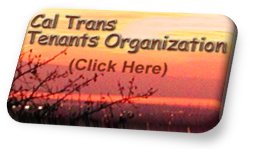
|
as told by the Press June 17, 1981 |
South County The Daily Review, Wednesday, June 17, 1981 Page 17Rent hikes may doom home hopes
|
Daily Review May 17, 1982
Bypass project at critical juncture
|
County The Daily Review, Thursday, September 23, 1982 Page 13
State renters rally for homes
|
The Daily Review, Thursday, September 30, 1982State poor landlord, tenants tell council
|
South County
The Daily Review, Sunday, January 30, 1983 Page 13
|
California Lawyer December 1984Highways and low rents
|
The Tribune Wednesday, May 7, 1986 *SC Section B.LOCAL
1,000 could lose homes to foothill freeway
|
16 The Daily Review Thursday, May 29, 1986Caltrans, city OK deal for tenants
|
THE DAILY REVIEW Monday, June 25, 1990
Caltrans criticized as a poor landlord
| Excerpts From Route 238 Final Environmental Impact Statement |
Route 238 Foothill Parkway Final Environmental Impact Statement "Social and Economic - The major socio-economic impacts of the Preferred Alternative would include the direct displacement of 219 single-family residences 17 duplexes, 5 condominiums and 22 multi-family residences. The majority of the requisite properties were acquired between 1965 and 1971 during the early development of the project. An estimated 112 units are still in private ownership. The project would require the displacement of 17 businesses, two of which are non-profit organizations. There are an additional 142 housing units and six business units, currently owned by the State, in areas that are no longer needed for the project and will be declared excess. This extensive displacement constitutes a major socio-economic impact. However, the State and the City of Hayward relocation assistance and replenishment housing programs will mitigate this impact. All tenants displaced by the Preferred Alternative will receive relocation assistance. Relocation assistance will be provided to pre-acquisition occupants (original occupants before State acquisition of the right-of-way) pursuant to Federal and State Uniform Relocation Assistance Acts and to post-acquisition tenants (tenants who rented after State acquisition of the right-of-way) under the Consent Decree Relocation Plan and special legislation for the Local Alternative Transportation Improvement Program (LATIP) who would not otherwise be eligible for relocation benefits." (Final Environmental Impact Statement)
HOUSING REPLENISHMENT AND RELOCATION The City and the State are to comply with the Federal Uniform Relocation Assistance and Real Properties Acquisitions Policies Act of 1970 and any other applicable federal or State laws.
1. The City is responsible for implementing the Relocation Plan for tenants who moved into property within the corridor after it was acquired by the State or the City or who did not know the property was owned by the State at the time they moved into the property ("post-acquisition occupants") Residential occupants residing in the property at the time of the Notice of Entitlement to Relocation Benefits are entitled to either a moving expense payment of $500 and a rental differential payment of $5,250, or a down payment contribution of $5,750. Commercial occupants are eligible to receive a moving expense payment of $500 and a business relocation payment of $5,250. Hardship relocation may also be provided on a case-by-case basis.
2. The State is responsible for providing relocation assistance, including relocation benefits to residential occupants whose property was acquired by the State at the time of their occupancy or ownership, who presently occupy or own parcels in the corridor that have not yet been acquired by the State or the city, who moved into the corridor after acquisition by the State and who did not have knowledge of the State acquisition, or who otherwise have eligibility for relocation benefits under the State's rules and regulations (hereinafter referred to as "pre-acquisition occupants").
3. The State shall provide pre-acquisition commercial occupants with actual, reasonable and necessary moving costs, certain related expenses, search costs not to exceed $1,000 in finding a new business location for certain eligible tenants and in-lieu payments for those unable to stay in business for certain eligible tenants of up to $10,000.
4. The City is responsible for implementing the Replenishment Housing Program and ensuring the initial availability of 247 affordable replenishment housing units for low income households, at least 111 of which shall be affordable for very low income households, 101 affordable replenishment housing units for moderate income households, and 101 additional replenishment housing units (48 of which shall be affordable by low income households and 53 affordable by moderate income households) if the freeway alternative is adopted as the Approved Transportation Program and subject to the City's acquisition from State of certain properties listed in Exhibit "E" to the Consent Decree (Revised). The above listed replenishment unit obligation will be credited for existing housing units that are within the right-of-way corridor which are not needed for construction and whose use is restricted to housing for low and moderate income households for 15 years.
5. The City shall also maintain the Housing and Relocation Fund. The Fund shall be maintained so as to reserve the amount estimated to be necessary for payment of relocation benefits and moving expenses to post-acquisition occupants and certain pre-acquisition occupants as referred to above." (Final Environmental Impact Statement)
Settlement Agreement Has Been Reached There have been ongoing negotiations on the Route 238 Bypass lawsuit involving the City of Hayward, CalTrans and the tenants in the CalTrans properties. A draft Settlement Agreement was presented to a meeting of the CalTrans tenants on September 28th (with Assemblywoman Mary Hayashi and Senator Ellen Corbett in attendance) and was approved by the Hayward City Council on October 6th. Documents below:September 28, 2009 - Material from City of Hayward and CalTrans Community Meeting of 238 Corridor Residential TenantsDecember 14, 2009 - Alameda County Staff Report, Update on 238 Corridor presented to the Castro Valley Municipal Advisory Council
